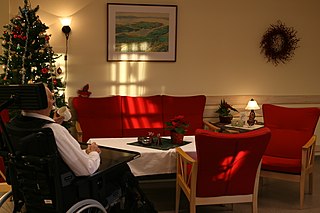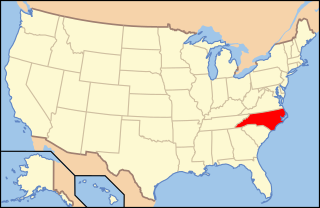
In the United States, Medicaid is a government program that provides health insurance for adults and children with limited income and resources. The program is partially funded and primarily managed by state governments, which also have wide latitude in determining eligibility and benefits, but the federal government sets baseline standards for state Medicaid programs and provides a significant portion of their funding.
Supplemental Security Income (SSI) is a means-tested program that provides cash payments to disabled children, disabled adults, and individuals aged 65 or older who are citizens or nationals of the United States. SSI was created by the Social Security Amendments of 1972 and is incorporated in Title 16 of the Social Security Act. The program is administered by the Social Security Administration (SSA) and began operations in 1974.

Temporary Assistance for Needy Families is a federal assistance program of the United States. It began on July 1, 1997, and succeeded the Aid to Families with Dependent Children (AFDC) program, providing cash assistance to indigent American families through the United States Department of Health and Human Services. TANF is often simply referred to as welfare.

Long-term care (LTC) is a variety of services which help meet both the medical and non-medical needs of people with a chronic illness or disability who cannot care for themselves for long periods. Long-term care is focused on individualized and coordinated services that promote independence, maximize patients' quality of life, and meet patients' needs over a period of time.
The Assured Income for the Severely Handicapped (AISH) is a provincial program established in 1979 in Alberta, Canada, that provides financial and health related benefits to eligible adult Albertans under the age of 65, who are legally identified as having severe and permanent disabilities that seriously impede the individual's ability to earn a living. The total AISH caseload was 69,785 in 2020, which represents 1.6% of Alberta's population. For those eligible for AISH, benefits include a monthly payment, as well as access to a number of services and/or subsidies, including prescriptions, dental and optical services. In 2020, the primary medical conditions of 44.1% of AISH recipients were related to physical disabilities, 30.4% were related to mental illness disorders, and 25.4% to cognitive disorders, and over 40% of AISH recipients were over fifty years of age. By 2020, the maximum AISH rate for a single person was C$1,685 per month. AISH was indexed to the Consumer Price Index in 2018, de-indexed in 2020, and is being indexed again beginning January 2023. Since 1998, there has been a C$100,000 limit on the amount of liquid assets an AISH recipient can possess. There is also a dollar for dollar claw back on any form of additional income above a set amount that an individual or a family unit receiving AISH, might earn or receive. Such offsets include federal aid, such as Canadian Emergency Response Benefit (CERB), Canada Pension Plan (CPP) disability benefits, a spouse's income, disability benefits through a private insurance plan, and/or Worker Compensation Board (WCB) benefits.
The California Medical Assistance Program is the California implementation of the federal Medicaid program serving low-income individuals, including families, seniors, persons with disabilities, children in foster care, pregnant women, and childless adults with incomes below 138% of federal poverty level. Benefits include ambulatory patient services, emergency services, hospitalization, maternity and newborn care, mental health and substance use disorder treatment, dental (Denti-Cal), vision, and long-term care and support. Medi-Cal was created in 1965 by the California Medical Assistance Program a few months after the national legislation was passed. Approximately 15.28 million people were enrolled in Medi-Cal as of September 2022, or about 40% of California's population; in most counties, more than half of eligible residents were enrolled as of 2020.
A group home, congregate living facility, care home, adult family home, etc., is a structured and supervised residence model that provides assisted living and medical care for those with complex health needs. Traditionally, the model has been used for children or young people who cannot live with their families or afford their own homes, people with chronic disabilities who may be adults or seniors, or people with dementia and related aged illnesses. Typically, there are no more than six residents, and there is at least one trained caregiver there 24 hours a day. In some early "model programs", a house manager, night manager, weekend activity coordinator, and four part-time skill teachers were reported. Originally, the term group home referred to homes of 8 to 16 individuals, which was a state-mandated size during deinstitutionalization. Residential nursing facilities, also included in this article, may be as large in 2015 as 100 individuals, which is no longer the case in fields such as intellectual and developmental disabilities. Depending on the severity of the condition requiring one to need to live in a group home, some clients are able to attend day programs and most clients are able to live normal lifestyles.
The Oregon Health Plan is Oregon's state Medicaid program. It is overseen by the Oregon Health Authority.
The United States Social Security Administration's Ticket to Work and Self-Sufficiency Program is the centerpiece of the Ticket to Work and Work Incentives Improvement Act of 1999.
The Ohio Department of Aging is the administrative department of the Ohio state government responsible for delivery of services and support that improves and promotes quality of life and personal choice for older Ohioans, adults with disabilities, their families and their caregivers. The director of the department is the chief advisor to the Governor concerning issues affecting older Ohioans and policy changes at the federal Administration on Aging.

In the United States, federal and state social programs include cash assistance, health insurance, food assistance, housing subsidies, energy and utilities subsidies, and education and childcare assistance. Similar benefits are sometimes provided by the private sector either through policy mandates or on a voluntary basis. Employer-sponsored health insurance is an example of this.
The Pennsylvania Department of Aging is a cabinet-level agency charged with providing aid to Pennsylvania's approximately three million individuals age 60 and older. Although the bureau operates some services directly, such as the Pharmaceutical Contact for the Elderly (PACE) prescription drug program, it generally serves as a clearinghouse of funding and information for county-level Area Agencies on Aging. The department was formed under the governorship of Milton Shapp.
Disability benefits are funds provided from public or private sources to a person who is ill or who has a disability.
The Human Resources Administration or Department of Social Services (HRA/DSS) is the department of the government of New York City in charge of the majority of the city's social services programs. HRA helps New Yorkers in need through a variety of services that promote employment and personal responsibility while providing temporary assistance and work supports. Its regulations are compiled in title 68 of the New York City Rules. The current Commissioner of HRA is Molly Wasow Park, who was appointed to the position by Mayor Eric Adams. HRA is the largest city social services agency in the United States. It has a budget of $9.7 billion, employs over 14,000 people, and serves over 3 million New Yorkers.
Intermediate Care Facilities for Individuals with Intellectual Disabilities (ICF/IID), formerly known as Intermediate Care Facilities for Mental Retardation (ICF/MR), is an American Medicaid-funded institutional long-term support and service (LTSS) for people with intellectual disabilities or related conditions. Section 1905(d) of the Social Security Act enacted benefits and made funding available for "institutions" for individuals with intellectual or related conditions. According to federal law 42 CFR § 440.150 the purpose of ICD/IIDs is to "furnish health or rehabilitative services to persons with Intellectual Disability or persons with related conditions."

The state of North Carolina is undertaking a comprehensive policy shift on how the government budgets for and manages resources for mental health, developmental disability, and substance abuse services. The 1915 (b)(c) Medicaid Waiver Program was chosen by the North Carolina Department of Health & Human Services, Division of Medical Assistance as a way to control and more accurately budget for the rising costs of Medicaid funded services. The 1915 (b)(c) Waiver Program was initially implemented at one pilot site in 2005 and evaluated for several years. Two expansion sites were then added in 2012. Full statewide implementation is expected by July 1, 2013.
The Utah HCBS waiver program is a state-run program that serves individuals in Utah with intellectual disabilities or related conditions (ID/RC). HCBS stands for Home and Community-Based Services.
As of 2017, approximately 1.4 million Americans live in a nursing home, two-thirds of whom rely on Medicaid to pay for their care. Residential nursing facilities receive Medicaid federal funding and approvals through a state health department. These facilities may be overseen by various types of state agency.

Home and Community-Based Services waivers or Section 1915(c) waivers, 42 U.S.C. Ch. 7, § 1396n §§ 1915(c), are a type of Medicaid waiver. HCBS waivers expand the types of settings in which people can receive comprehensive long-term care under Medicaid. Prior to the creation of HCBS waivers, comprehensive long-term care was available through Medicaid only in institutional settings. Under an HCBS waiver, states can use Medicaid funds to provide a broad array of non-medical services not otherwise covered by Medicaid, if those services allow recipients to receive care in community and residential settings as an alternative to institutionalization.
Sunrise Community, Inc., is one of the private 501(c)(3) not-for-profit organizations in the country for people with intellectual and developmental disabilities. Much of the organization's early growth can be attributed to assisting state agencies with deinstitutionalization efforts, and in more recent years, Sunrise has welcomed smaller companies in need of assistance or support into the Sunrise Group. As a result, over the last 50 years Sunrise has increased the number of persons served from 50 people in just South Florida to over 2,000 across several states with over 3,000 employees.




